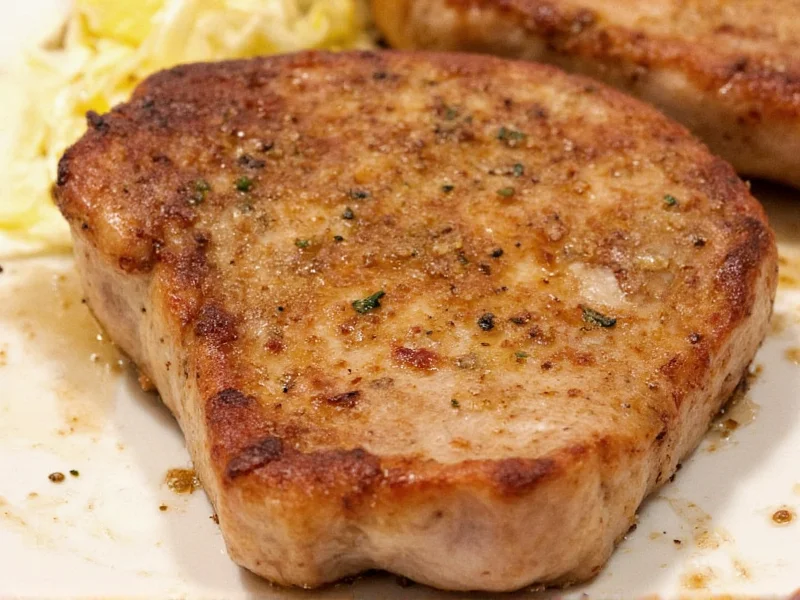Seasoning pork chops properly transforms this versatile cut from bland to extraordinary. Understanding which spices complement pork's natural sweetness while enhancing its texture is essential for creating restaurant-quality results at home. This guide provides practical, tested approaches to seasoning pork chops that deliver consistent, delicious outcomes.
Why Proper Seasoning Matters for Pork Chops
Pork chops benefit significantly from thoughtful seasoning due to their relatively mild flavor profile compared to fattier cuts like pork shoulder. The right combination of spices not only enhances taste but also creates a flavorful crust during cooking that locks in moisture. Unlike beef, pork has a natural sweetness that pairs exceptionally well with both warm spices and fresh herbs.
Essential Components of Pork Chop Seasoning
An effective pork chop seasoning blend contains four key elements working in harmony:
| Component | Purpose | Common Examples |
|---|---|---|
| Salt | Enhances natural flavors and modifies protein structure | Kosher salt, sea salt |
| Pepper | Provides heat and complexity | Black pepper, white pepper |
| Aromatic Spices | Adds depth and warmth | Garlic powder, onion powder, paprika |
| Herbal Notes | Contributes freshness and brightness | Thyme, rosemary, sage |
Classic Pork Chop Seasoning Combinations
These reliable seasoning blends work for most cooking methods and preferences. Each makes enough for 4 standard pork chops (about 1 inch thick):
Basic All-Purpose Blend
This simple pork chop seasoning creates a perfect foundation for everyday cooking. Combine:
- 1½ teaspoons kosher salt
- 1 teaspoon freshly ground black pepper
- 1 teaspoon garlic powder
- ½ teaspoon onion powder
- ½ teaspoon smoked paprika
Herb-Infused Variation
For those who prefer fresh herbal notes, this blend adds garden-fresh flavor:
- 1½ teaspoons kosher salt
- 1 teaspoon black pepper
- 1 teaspoon dried thyme (or 1 tablespoon fresh)
- 1 teaspoon dried rosemary (or 1 tablespoon fresh, finely chopped)
- ½ teaspoon garlic powder
Creative Flavor Profiles for Adventurous Cooks
Once you've mastered basic seasoning for pork chops, experiment with these distinctive flavor combinations that answer what spices go well with pork chops in more creative ways:
Apple Cider & Spice Rub
This autumn-inspired blend complements pork's natural sweetness:
- 1 teaspoon kosher salt
- 1 teaspoon brown sugar
- ½ teaspoon cinnamon
- ½ teaspoon allspice
- ¼ teaspoon cayenne (optional for heat)
- 1 teaspoon apple cider vinegar (applied before dry rub)
Cajun-Style Pork Chop Seasoning
For those seeking bold flavors in their pork chop spice rub recipes:
- 1½ teaspoons kosher salt
- 1 teaspoon paprika
- ½ teaspoon garlic powder
- ½ teaspoon onion powder
- ½ teaspoon dried oregano
- ½ teaspoon cayenne pepper
- ¼ teaspoon thyme
When and How to Season Pork Chops Properly
Timing matters as much as the seasoning blend itself. Understanding how to season pork chops before cooking significantly impacts results:
- Salt early: Apply salt 45-60 minutes before cooking to allow it to penetrate the meat. This improves both flavor and texture.
- Dry spices later: Add other dry spices no more than 15-20 minutes before cooking to prevent burning and preserve volatile flavor compounds.
- Pat dry: Always dry the surface with paper towels before seasoning for better adhesion and crust formation.
- Generous application: Don't be shy—season both sides thoroughly for balanced flavor.
Common Seasoning Mistakes to Avoid
Even with the best pork chop seasoning mix, these errors can ruin your results:
- Sugary rubs too early: If your seasoning contains sugar, apply it no more than 15 minutes before cooking to prevent burning.
- Underseasoning: Pork chops need more seasoning than many home cooks apply—remember that some salt gets lost during cooking.
- Seasoning frozen chops: Always thaw completely before seasoning for proper absorption.
- Not resting after cooking: Let pork chops rest 5 minutes after cooking before serving to allow juices to redistribute.
Complementary Cooking Techniques
The right cooking method enhances your seasoning efforts. For best results with your seasoned pork chops:
- Start with room-temperature chops (take them out of the refrigerator 30 minutes before cooking)
- Use high heat initially to create a flavorful crust, then finish at moderate temperature
- Cook to an internal temperature of 140-145°F (60-63°C), then let rest to reach the safe 145°F (63°C) final temperature
- Consider finishing with a pat of herb butter for extra richness
Customizing for Different Pork Chop Cuts
Not all pork chops season the same way. Adjust your approach based on the cut:
- Loin chops: Leaner cut that benefits from more aggressive seasoning and careful cooking to prevent drying
- Shoulder chops: More marbling means they can handle bolder seasonings and higher heat
- Bone-in versus boneless: Bone-in chops generally need slightly longer seasoning time as the bone affects heat distribution











 浙公网安备
33010002000092号
浙公网安备
33010002000092号 浙B2-20120091-4
浙B2-20120091-4